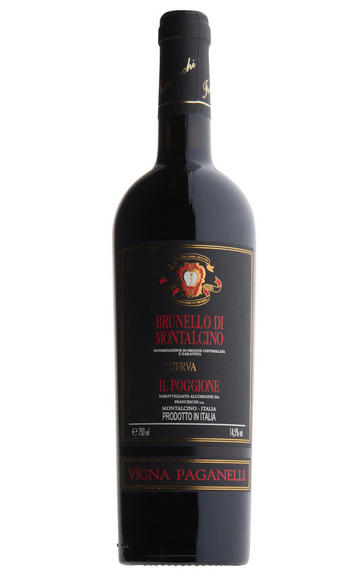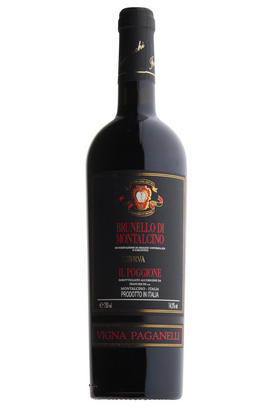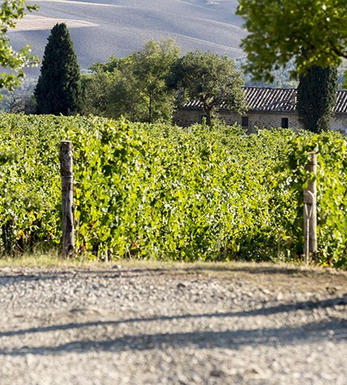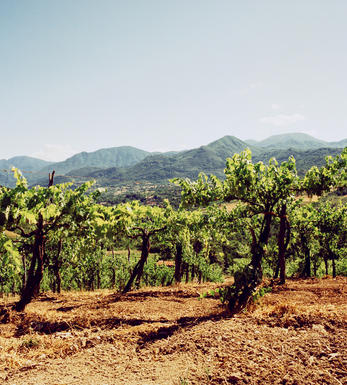
2004 Brunello di Montalcino, Vigna Paganelli, Riserva, Il Poggione,Tuscany, Italy

Critics reviews
This dark, brooding and authoritative Riserva from Il Poggione is simply gorgeous. Readers who don’t want to pay the premium for the Riserva in 2004 need not worry; I tasted the 2004 regular bottling (twice!) while preparing this article and it is every bit as promising as my review last year suggested. In 2004 the Paganelli vineyard was harvested on the 13th of October, quite late for this estate.
Father and son team Fabrizio and Alessandro Bindocci are on a roll. Il Poggione remains a benchmark property for fine, traditionally made Brunellos capable of ageing exquisitely. I can’t think of too many properties in the world producing wines of this level at these prices with an established track record going back 40+ years. I tasted an extraordinary range of wines at the estate in January 2010, including all of the Brunellos and Riservas in cask from vintages 2005-2009.
Antonio Galloni - Wine Advocate#188 - Apr 2010
About this WINE

Il Poggione
Il Poggione is a winery steeped in history with its origins dating back to the late 1800s. Owned by Leopoldo and Livia Franceschi , it is situated below the beautiful hilltop town of Sant’Angelo in Colle, a part of the Brunello di Montalcino appellation characterised by temperate, yet well-ventilated micro-climate. This benefits the grapes by maintaining refreshing acidity levels and extending their ripening time.
Father and son winemaking team Fabrizio and Alessandro Bindocci coax the best from these privileged vineyard sites; they are also proponents of a traditional wine-making style which includes submerging the cap with frequent pump overs (for more colour and tannin extraction), and ageing in large casks (so that wood flavours remain subtle and do not interfere with the natural expression of the Sangiovese and the Sant’Angelo terroir).
The Riserva bottling, made in the finest vintages, receives at least one year extra ageing in French oak casks. The typical style is intense, full-bodied, powerful, packed with dark fruit, menthol, sweet smoke, cocoa and spice flavours and a hint of earthiness.
In the best vintages the wines demonstrate extraordinary development in bottle. Even better, prices have remained very reasonable, considering the superb quality of the wine. Poggione’s straight Brunello is one of the most fairly-priced, cellar worthy wines of the appellation.
This is a benchmark property for fine, traditionally made Brunellos capable of ageing superbly.

Brunello di Montalcino
Along with Chianti, Brunello di Montalcino is Tuscany's most famous DOCG and the region's boldest expression of Sangiovese. Located 30 miles south of Siena with the hilltop town of Montalcino as its epicentre, its 2,000 hectares of vines are naturally delimited by the Orcia, Asso and Ombrone valleys. Brunello is the local name for the Sangiovese Grosso clone from which Brunello di Montalcino should be made in purezza (ie 100 percent).
The Brunello di Montalcino DOCG has a whale-like shape: at its head, at 661 metres above sea level on ancient, stony galestro soils facing east and southeast lies the town of Montalcino, where the DOC was founded. As you follow the spine south towards the tail, the vineyards lose altitude – those around Colle Sant'Angelo are at 250 metres – while the soils become richer with iron and clay. Further east, in the shadow of the 1,734 metre Mont'Amiata lies the village of Castelnuovo dell'Abate where the vineyards are strewn with a rich mix of galestro, granitic, volcanic, clay and schist soil types.
Historically, the zone is one of Tuscany's youngest. First praised in 1550 by Leandro Alberti for the quality of its wines, it was Tenuta Il Greppo who bottled the inaugural Brunello di Montalcino in 1888. By 1929, the region had 925 hectares of vines and 1,243 hectares of mixed crops, while in 1932 it was decreed that only those wines made and bottled within the commune could be labelled as Brunello di Montalcino. Since then, the number of producers has risen from 11 in 1960 to 230 in 2006, while over the same period the vineyards have expanded from 1,000 hectares to 12,000. The region earned its DOC in 1966, and was upgraded to DOCG in 1980.
Brunello di Montalcino cannot be released for sale until five years after the harvest, or six years in the case of Brunello di Montalcino Riserva. During this time the wines should be aged for at least two years in oak, followed by at least four months in bottle (six months for Riservas); maximum yields are 55 hl/ha.
Rosso di Montalcino is declassified Brunello di Montalcino, released for sale 18 months after the harvest.
Recommended producers: Costanti, Fuligni, Lisini, San Giuseppe, Soldera, Cerbaiona

Sangiovese
A black grape widely grown in Central Italy and the main component of Chianti and Vino Nobile di Montepulciano as well as being the sole permitted grape for the famed Brunello di Montalcino.
It is a high yielding, late ripening grape that performs best on well-drained calcareous soils on south-facing hillsides. For years it was blighted by poor clonal selection and massive overcropping - however since the 1980s the quality of Sangiovese-based wines has rocketed upwards and they are now some of the most sought after in the world.
It produces wines with pronounced tannins and acidity, though not always with great depth of colour, and its character can vary from farmyard/leather nuances through to essence of red cherries and plums. In the 1960s the advent of Super Tuscans saw bottlings of 100% Sangiovese wines, as well as the introduction of Sangiovese/Cabernet Sauvignon blends, the most famous being Tignanello.


Buying options
Add to wishlist
Description
The 2004 Brunello di Montalcino Riserva Vigna Paganelli emerges from the glass with masses of scorched earth, leather, tar, licorice, menthol and dark fruit. The Riserva shows a touch more inner sweetness, richness and depth in its fruit than the regular bottling, plus a bit more French oak as well. For now, the Riserva is quite reticent and requires air, but with time its awesome richness and power come through in spades.
This dark, brooding and authoritative Riserva from Il Poggione is simply gorgeous. Readers who don’t want to pay the premium for the Riserva in 2004 need not worry; I tasted the 2004 regular bottling (twice!) while preparing this article and it is every bit as promising as my review last year suggested. In 2004 the Paganelli vineyard was harvested on the 13th of October, quite late for this estate.
Father and son team Fabrizio and Alessandro Bindocci are on a roll. Il Poggione remains a benchmark property for fine, traditionally made Brunellos capable of ageing exquisitely. I can’t think of too many properties in the world producing wines of this level at these prices with an established track record going back 40+ years. I tasted an extraordinary range of wines at the estate in January 2010, including all of the Brunellos and Riservas in cask from vintages 2005-2009.
Antonio Galloni - Wine Advocate#188 - Apr 2010
wine at a glance
Delivery and quality guarantee